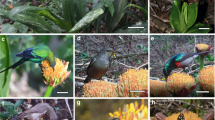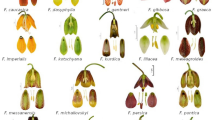Abstract
The Canary Islands are home to a guild of endemic, threatened bird-pollinated plants. Previous work has suggested that these plants evolved floral traits as adaptations to pollination by flower specialist sunbirds, but subsequently, they appear to have co-opted generalist passerine birds as sub-optimal pollinators. To test this idea, we carried out a quantitative study of the pollination biology of three of the bird-pollinated plants, Canarina canariensis (Campanulaceae), Isoplexis canariensis (Veronicaceae) and Lotus berthelotii (Fabaceae), on the island of Tenerife. Using colour vision models, we predicted the detectability of flowers to bird and bee pollinators. We measured pollinator visitation rates, nectar standing crops as well as seed-set and pollen removal and deposition. These data showed that the plants are effectively pollinated by non-flower specialist passerine birds that only occasionally visit flowers. The large nectar standing crops and extended flower longevities (>10 days) of Canarina and Isoplexis suggests that they have evolved a bird pollination system that effectively exploits these low frequency non-specialist pollen vectors and is in no way sub-optimal. Seed set in two of the three species was high and was significantly reduced or zero in flowers where pollinator access was restricted. In L. berthelotii, however, no fruit set was observed, probably because the plants were self-incompatible horticultural clones of a single genet. We also show that, while all three species are easily detectable for birds, the orange Canarina and the red Lotus (but less so the yellow-orange Isoplexis) should be difficult to detect for insect pollinators without specialised red receptors, such as bumblebees. Contrary to expectations if we accept that the flowers are primarily adapted to sunbird pollination, the chiffchaff (Phylloscopus canariensis) was an effective pollinator of these species.




Similar content being viewed by others
References
Allan GJ, Francisco-Ortega J, Santos-Guerra A, Boerner E, Zimmer EA (2004) Molecular phylogenetic evidence for the geographic origin and classification of Canary Island Lotus (Fabaceae: Loteae). Mol Phylogenet Evol 32:123–138
Ashman T-L, Schoen DJ (1994) How long should flowers live? Nature 371:788–791
Ashman T-L, Schoen DJ (1996) Floral longevity: fitness consequences and resource costs. In: Lloyd DG, Barrett SCH (eds) Floral Biology: Studies on floral evolution in animal-pollinated plants. Chapman and Hall, New York, pp 112–139
Bowmaker JK, Heath LA, Wilkie SE, Hunt DM (1997) Visual pigments and oil droplets from six classes of photoreceptors in the retinas of birds. Vision Res 37:2183–2194
Bramwell D, Bramwell Z (2001) Wild flowers of the Canary Islands. Editorial Rueda, Madrid
Bräuchler C, Meimberg H, Heubl G (2004) Molecular phylogeny of the genera Digitalis L. and Isoplexis (Lindley) Loudon (Veronicaceae) based on ITS- and trnL-F sequences. Plant Syst Evol 248:111–128
Carine MA, Russell SJ, Santos-Guerra A, Francisco-Ortega J (2004) Relationships of the Macaronesian and Mediterranean floras: Molecular evidence for multiple colonizations into Macaronesia and back-colonization of the continent in Convolvulus (Convolvulaceae). Am J Bot 91:1070–1085
Chittka L (1996) Optimal sets of colour receptors and opponent processes for coding of natural objects in insect vision. J Theo Biol 181:179–196
Chittka L (1997) Bee color vision is optimal for coding flower colors, but flower colors are not optimal for being coded—why? Israel J Plant Sci 45:115–127
Chittka L, Raine NE (2006) Recognition of flowers by pollinators. Curr Opin Plant Biol 9:428–435
Chittka L, Ings TC, Raine NE (2004) Chance and adaptation in the evolution of island bumblebee behaviour. Popul Ecol 46:243–251
Clement P (1995) The chiffchaff. Hamlyn, London
Dafni A, Kevan PG, Husband BC (2005) Practical pollination biology. Enviroquest, Cambridge
Dupont YL, Olesen JM (2004) Fugleblomster på de Kanariske Øer. Naturens Verden 87:2–11
Dupont YL, Skov C (2004) Influence of geographical distribution and floral traits on species richness of bees (Hymenoptera: Apoidea) visiting Echium species (Boraginaceae) of the Canary Islands. Int J Plant Sci 165:377–386
Dupont YL, Hansen DM, Olesen JM (2003) Structure of a plant-flower-visitor network in the high-altitude sub-alpine desert of Tenerife, Canary Islands. Ecography 26:301–310
Dupont YL, Hansen DM, Rasmussen JT, Olesen JM (2004) Evolutionary changes in nectar sugar composition associated with switches between bird and insect pollination: the Canarian bird-flower element revisited. Funct Ecol 18:670–676
Francisco-Ortega J, Santos-Guerra A, Kim SC, Crawford DJ (2000) Plant genetic diversity in the Canary Islands: A conservation perspective. Am J Bot 87:909–919
Galetto L, Bernardello L (1992) Nectar secretion pattern and removal effects in six Argentinean Pitcairnioideae (Bromeliaceae). Bot Act 105:292–299
Garcia JDD (2000) Patterns of insect flower visitation in Lavandula bucchii Webb (Lamiaceae), an endemic shrub of Tenerife (Canary Islands). J Nat Hist 34:2145–2155
Gill R, Thirlwall M, Marriner G, Millward D, Norry M, Saunders A, Martí J (1994) Tenerife, Canary Islands: Geologists’ Association Guide No. 49. Geologists’ Association, London
Giurfa M, Vorobyev M, Kevan P, Menzel R (1996) Detection of coloured stimuli by honeybees: minimum visual angles and receptor specific contrasts. J Comp Physiol A 178:699–709
Gumbert A, Kunze J, Chittka L (1999) Flower color diversity in plant communities, bee color space, and a null model. P Roy Soc Lond B Bio 266:1711–1716
Hart NS (2001) The visual ecology of avian photoreceptors. Prog Retin Eye Res 20:675–703
Hart NS, Vorobyev M (2005) Modelling oil droplet absorption spectra and spectral sensitivities of bird cone photoreceptors. J Comp Physiol A 191:381–392
Hart NS, Partridge JC, Cuthill IC, Bennett ATD (2000) Visual pigments, oil droplets and cone photoreceptor distribution in two species of passerine bird: the blue tit (Parus caerulus L.) and the blackbird (Turdus merula L.). J Comp Physiol A 186:375–387
Heinrich B (1979) Bumblebee economics. Harvard University Press, Cambridge
Johnson SD, Nicolson SW (2007) Evolutionary associations between nectar properties and specificity in bird pollination systems. Biology Letters 4(1):49–52 doi:10.1098/rsbl.2007.0496
Kearns CA, Inouye DW (1993) Techniques for pollination biologists. University Press of Colorado, Niwot
Kevan PG, Backhaus W (1998) Color vision: ecology and evolution in making the best of the photic environment. In: Backhaus W, Kliegl R, Werner JS (eds) Color vision - perspectives from different disciplines. Gruyter, Berlin, pp 163–183
Kevan PG, Chittka L, Dyer AG (2001) Limits to the salience of ultraviolet: lessons from colour vision in bees and birds. J Exp Biol 204:2571–2580
Lems K (1960) Botanical notes on the Canary Islands II. The evolution of plant forms in the islands: Aeonium. Ecology 41:1–17
Mabberley DJ (1990) The plant book. Cambridge Univerity Press, Cambridge
Nicolson SW, Fleming PA (2003) Nectar as food for birds: the physiological consequences of drinking dilute sugar solutions. Plant Syst Evol 238:139–153
Olesen JM (1985) The Macaronesian bird-flower element and its relation to bird and bee opportunists. Bot J Linn Soc 91:395–414
Ollerton J, Grace J, Smith K (2007) Pollinator behaviour and adaptive floral colour change in Anthophora alluadii (Hymenoptera: Apidae) and Erysimum scoparium (Brassicaceae) on Tenerife. Entomol Gen 29:253–268
Ortega-Olivencia A, Rodríguez-Riaño T, Valtueña FJ, López J, Devesa JA (2005) First confirmation of a native bird-pollinated plant in Europe. Oikos 110:578–590
Primack RB (1985) Longevity of individual flowers. Annu Rev Ecol Syst 16:15–37
Proctor M, Yeo P, Lack A (1996) The natural history of pollination. HarperCollins, London
Rodríguez MC and Valido A (2008) Effectiveness of opportunistic passerine pollinators of Isoplexis canariensis (Scrophulariaceae). In: The Evolutionary Ecology of Plant Animal Interactions: from Genes to Communities: Ecoevolutiva Symposium, Abstract Volume, p.77
Silvertown J (2004) The ghost of competition past in the phylogeny of island endemic plants. J Ecol 92:168–173
Skorupski P, Doering T, Chittka L (2007) Photoreceptor spectral sensitivity in island and mainland populations of the bumblebee, Bombus terrestris. J Comp Physiol A 193:485–494
Stelzer R, Ollerton J, Chittka L (2007) Kein Nachweis für Hummelbesuch der Kanarischen Vogelblumen (Hymenoptera: Apidae). Entomol Gen 30:153–154
Valido A, Dupont YL, Hansen DM (2002) Native birds and insects, and introduced honeybees visiting Echium wildpretii (Boraginaceae) in the Canary Islands. Acta Oecologica 23:413–419
Valido A, Dupont YL, Olesen JM (2004) Bird-flower interactions in the Macaronesian islands. J Biogeogr 31:1945–1953
Valtueña FJ, Ortega-Olivencia A, Rodriguez-Riano T (2007) Nectar production in Anagyris foetida (Fabaceae): Two types of concentration in flowers with hanging droplet. Int J Plant Sci 168:627–638
Vogel S (1954) Blütenbiologische Typen als Elemente der Sippengliederung. Botanische Studien (Jena) 1:1–338
Vogel S, Westerkamp C, Thiel B, Gessner K (1984) Ornithophilie auf den Canarischen Inseln. Plant Syst Evol 146:225–248
Willis DS, Kevan PG (1995) Foraging dynamics of Peponapis pruinosa (Hymenoptera: Anthophoridae) on Pumpkin (Cucurbita pepo) in Southern Ontario. Can Entomol 127:167–175
Woodell SRJ (1979) The role of unspecialized pollinators in the reproductive success of Aldabaran plants. Phil Trans R Soc Lond B 286:99–108
Wyszecki G, Stiles WS (1982) Color science: Concepts and methods, quantitative data and formulae, Volume 2. Wiley, New York
Acknowledgements
This research was funded by NERC grant number NER/B/S/2003/00811. We are grateful to Servicio Administrativo de Medio Ambiente, Excmo. Cabildo Insular de Tenerife for permission to work in Tenerife (Permit DNI: 203067161), El Parque del Drago for allowing us to observe L. berthelotii, and to Sr. Damián de Torres for assisting with resources and providing local knowledge. Thanks to Dr. Yoko Dupont for information on field sites, Dr. Ana Ortega-Olivencia for sharing originally unpublished data on A. foetida flower longevity, and Dr. Tia-Lynn Ashman for discussion. All experiments comply with the current laws of the country in which they were performed.
Author information
Authors and Affiliations
Corresponding author
Rights and permissions
About this article
Cite this article
Ollerton, J., Cranmer, L., Stelzer, R.J. et al. Bird pollination of Canary Island endemic plants. Naturwissenschaften 96, 221–232 (2009). https://doi.org/10.1007/s00114-008-0467-8
Received:
Revised:
Accepted:
Published:
Issue Date:
DOI: https://doi.org/10.1007/s00114-008-0467-8




